Micro Moves of A Correct Backswing
By Kelvin Miyahira
French Transltion by Robin Cocq CLICK HERE
For many amateur golfers, the flaws start early on in their backswings and then a great downswing becomes a dream or a journey of compensations. Many movements that we’d like to do on the downswing are impossible due to stretch shorten cycles or actions/reactions that we’ve triggered off in the backswing. Thus, no matter how hard you try and how much work you put into the great downswing moves, hardly any improvement takes place. So let’s change that starting today. We’re going to give the backswing spine/pelvic movements a microscopic investigation.
Trunk Balance
A few years ago, I wrote about trunk balance in a general way. Admittedly, I knew something was very important about it but wasn’t quite sure about all the underlying micro movements were to create such balance. But after more years of study and understanding more about spine and pelvis mechanics, I understand at a deeper level what is really going on. So let’s take a closer look at this very important aspect of the backswing this month because it could be the reason you cannot stop sliding, jumping, over the top swinging, stalling and therefore still flipping or flip/rolling it like crazy.
Old, simple view
 |
 |
I drew lines delineating the torso at address then looked to see if the golfer was in “balance” or not. From this view, the elite players typically have their weight more up and away from the ball versus being more toward the ball (in addition to being more right side loaded from front view).

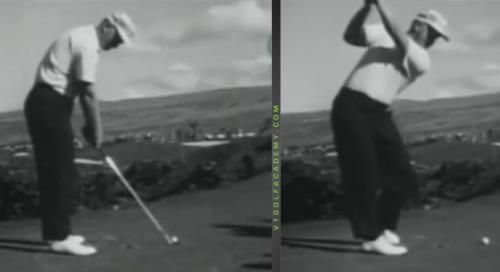
Jack Nicklaus has great trunk balance.
 |
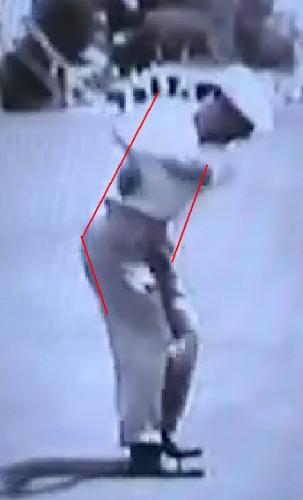 |
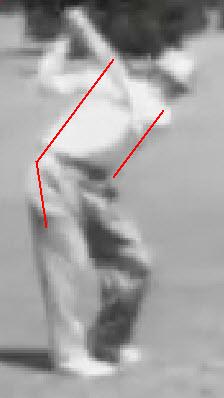 |
The weight in the trunk is moved away from the ball and to the right. Legends Sam Snead and Ben Hogan looked similar.
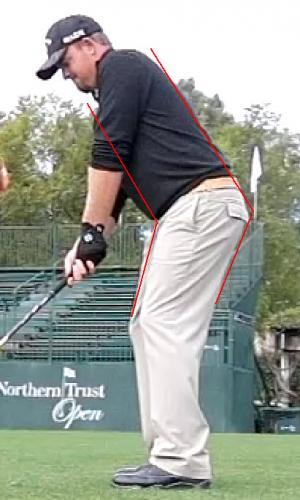 |
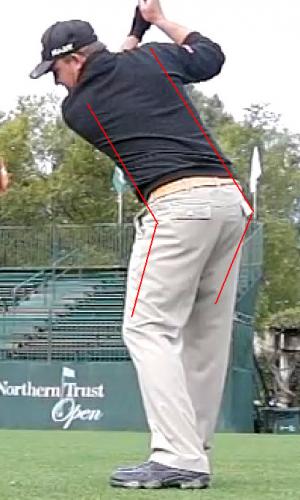 |
After looking at more of the swings from the reverse target line view, I noticed that some player’s spines had a different bend, shape and position.
 |
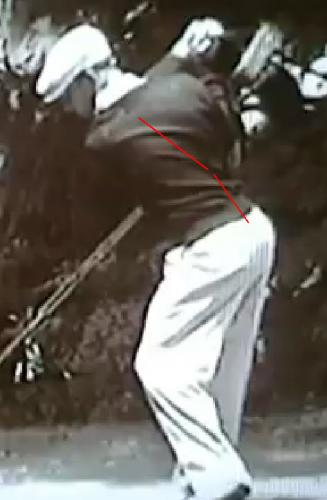 |
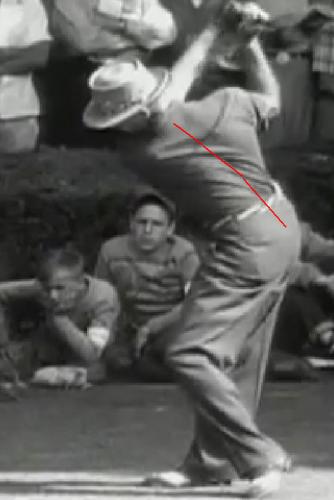 |
So here’s JB Holmes from the reverse target line view and we see “shoulder turn” of around 90 degrees while the spine is laterally bent toward the left. Ben Hogan and Sam Snead show similar spine bend.
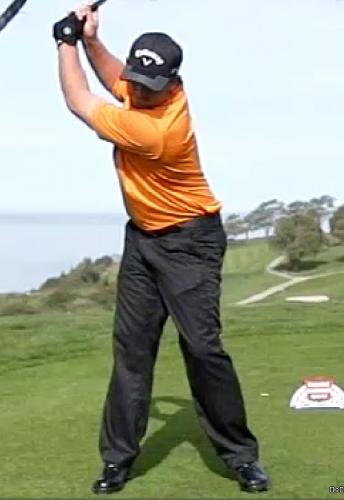
Here’s what JB looks like from the front view.
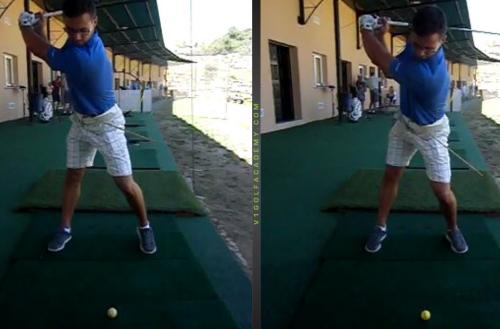
Here’s Fabian Lozano, certified teacher from Spain. He’s modeling how and how NOT to do the backswing. If you’ll look carefully at the moves/positions he’s in, it can be vastly different from what is correct. So let’s take a closer look.
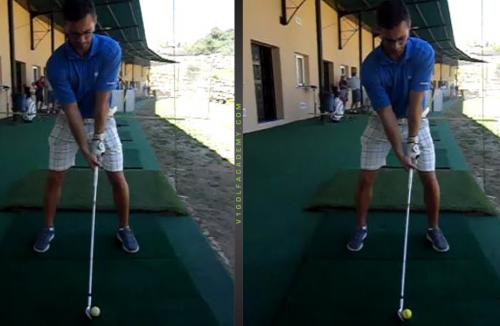
Address is same in both cases.
Takeaway Moves
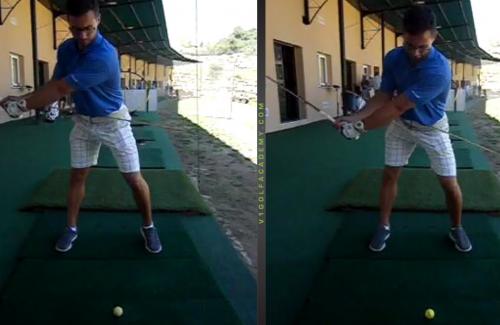
The takeaway shows several key different moves. On the left is correct while on the right is incorrect. See alignment rod inserted into belt loops to show frontal plane pelvic tilt.
- Right hip adduction/left hip abduction vs. right hip abduction/left hip adduction
- Both knees extending vs. large amount of left knee flexion
- Pelvis staying more level vs. large left pelvic tilt
- Spine extending up (sagittal plane)/slight right lateral bend vs. spine flexion (sagittal plane)/left lateral bend
The movements in the takeaway are tipping us off to where he’ll be at the top of the backswing.
Top of the Backswing

A correctly performed backswing has movements in the spine that I have not discussed before. First, a slight lateral bend to the right on the takeaway helps to load opposing muscles to create the left lateral bend that is proper for the top of the backswing. Also, this is starting to load the trunk onto the right side.
Of course, this left lateral bend at the top of the backswing stretches/loads the muscles facilitating the right lateral bend that we know we want to use during the downswing.
The alternating of lateral bend is important for you to load up correctly on the right side and be mobile. The notion that you should keep a stiff, straight, stable spine is just a fallacy.
See huge left pelvic tilt as seen from alignment stick in belt loops (picture on the right)? But there is also some contribution of the additional left knee flexion to the more tilted pelvis.
In other words, collapsing the left side of the body can start from the ground and affect entire body above. A left knee that flexes more tilts the left side of pelvis down which in turn will cause the left shoulder to drop more as well.
Reverse Target Line View
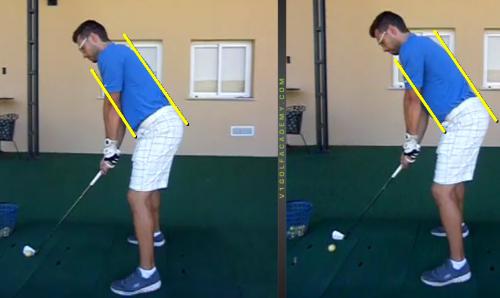

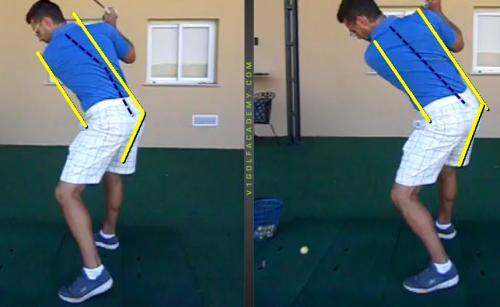
What we are seeing on the right picture is the entire spine gets lowered down toward the ball. The 2D frontal plane view of the spine is that it is straighter as well or if anything it might have a slight lateral bend to the right. Many players with an overly flat backswing plus this spine movement tend to retract the right scapula even more which typically straightens the spine and in severe cases, bends the spine more to the right. What does this do to your downswing? We’ll look at a couple of examples of this later.
Compensatory Moves
Weight movement
If your trunk weight is down, to the target and toward the ball, AND you’re athletic, you will naturally shift more down, more toward the target and even closer toward the ball. That combination of moves is natural and athletic. But then wouldn’t you be too close to the ball and jamming yourself?

So he’s got two choices, he’s going to slide forward more (some people like this) or jump up and away from the ball to make space (some people like this too and call it “extension”). Remember these choices, this is very important.
Tiger Woods 2000 vs 2014
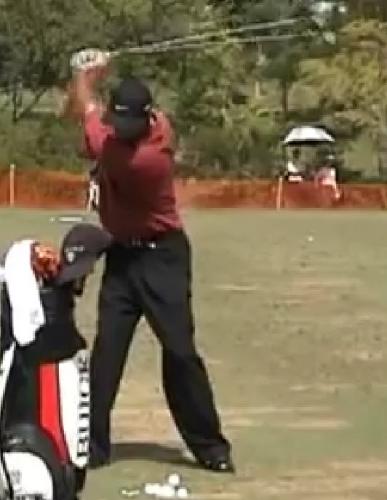 |
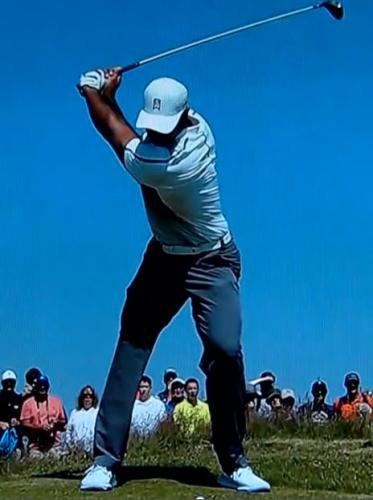 |
What did Tiger 2000 do different on the backswing than Tiger 2014 British Open? Let’s look at the micro moves.
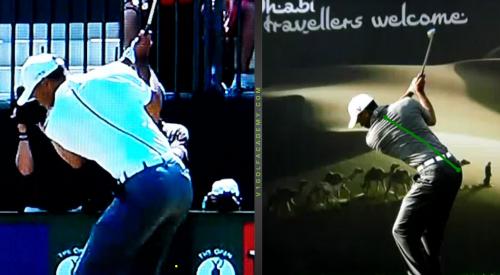
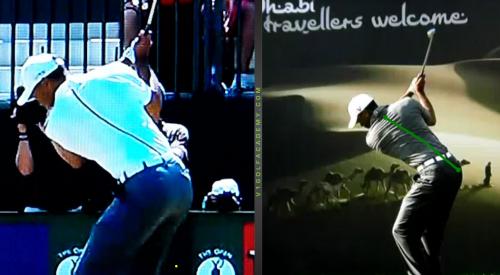
Early 2013 in Abu Dhabi (while still winning), Tiger had a left lateral bend and TSE at the top of his backswing. At the British open 2014, he’s got a bit of spine curvature in to the right while staying more in flexion in his thoracic spine (due to back injury or someone teaching him spine stability?).
| Tiger 2000 | Tiger 2014 |
| Left lateral bend of spine | Right lateral bend |
| Trunk weight moved up, to the right and away from the ball | Trunk weight moved down, to the left and toward the ball |
| Slight tilt left pelvis (frontal plane) | Large left pelvic tilt |
| Neutral to slight posterior pelvic tilt (sagittal plane) | Anterior pelvic tilt |
| Hip extension | Hip flexion |
| Right knee extension | Right knee flexion |
| Left knee extension to LH IR with minimal flexion | Left knee flexion along with ER |
| Right hip external rotation in early backswing to internal rotation at end of backswing | Right hip internal rotation only |
| Left hip external rotation to internal rotation | External rotation only |
| Right hip ADD to slight AB (creates right side loading) | Only AB (left side loading) |
| Left hip AB to slight ADD (complementary movement of above) | Only ADD |
| Overall spine is in flexion – leaning away from target | Less spine flexion – more toward extension |
| Spine has slight right lateral bend on takeaway to left lateral bend at top of backswing (from reverse target line view) | Spine lateral bend to left on takeaway then reduced to a straight and even possible right lateral bend with a flatter swing |
| Thoracic spine extension | Limited thoracic spine extension (could be due to injury or training to reduce) |
| Left hip joint axis dominated (right hip pulled back away from ball) | Right hip joint axis dominated (left hip moves forward toward ball) |
I’m going out on a limb and say that Tiger 2000’s moves were correct. Logically, if Tiger 2000 dominated with power and accuracy with those moves, then you change virtually every move on his backswing, wouldn’t that mean that currently, it’s not correct???
Or would you rather say, “It’s just different.” Or it’s an “accuracy swing” with a massive two-way miss?
I’m getting a clue...
From Golf Digest, "He started teaching Tiger with stuff that I thought was going to hurt Tiger, so I called him up and called b.s. on what he was doing," Cook said. "He took it in a great spirit, and we developed a dialogue on golf instruction, particularly as it relates to Tiger."
Pot calling kettle black??? We’ll come back to this later.
Brandt Snedeker
We don’t know what Sneds was taught growing up.

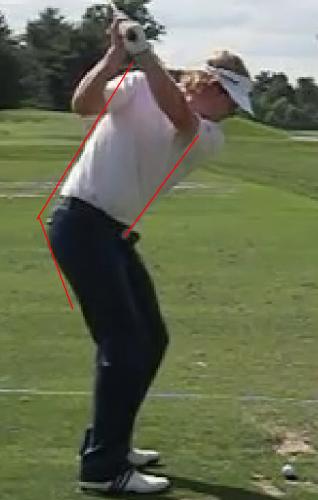
Here’s Brandt Snedeker who is struggling a bit at this time so he’s seeking help from Butch Harmon. Aside from the one great year he had, he’s been less spectacular. So what kind of difficulties might he be having? Taking a generalized look at his trunk balance shows his weight gets forward on his toes and a bit down toward the ball.

Can you see the slight loss of tush line at the top of the backswing? Or more correctly, he’s moved his spine toward the ball.

Then at impact he’s still a bit forward on his toes and crowding the ball.
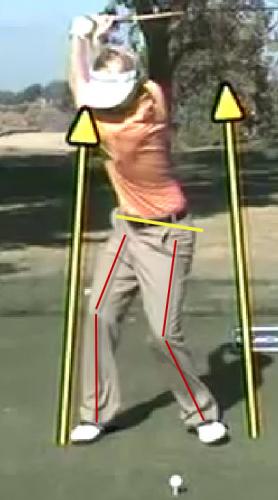 |
 |
At the top of the backswing, he’s flexed both his knees quite a bit, lowered his entire pelvis by doing so and also moved into a large left pelvic tilt. On his left side, he’s got more external rotation of his left hip via his left knee moving toward the ball while the pelvis rotates away. It may look like IR but it’s really ER.

Using the action/reaction principle, we see that his downswing is just a reflection of his backswing. So as he starts the downswing we see an extension of both knees, early lifting of his entire pelvis and a movement toward a more level pelvic tilt. Would you also imagine dual internal rotation of both hips too? Will Butch be able to patch the hole in the leaky roof? Or is this a crack in the foundation to the house that should be remedied?
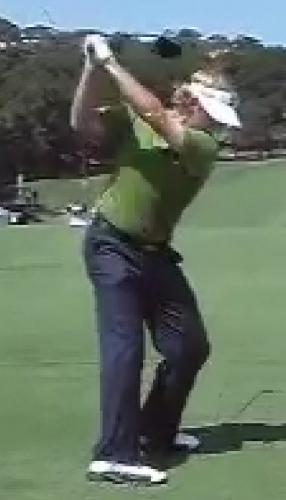 |
 |
BTW, found this video from 2007 of Sneds. The camera angles are different but he was absolutely in a better position at the top of the backswing in 2007. See the right knee more extended? He looks taller and has more hip rotation, left knee IR and even his clubface is in a better position (slightly closed by classic instruction standards!).
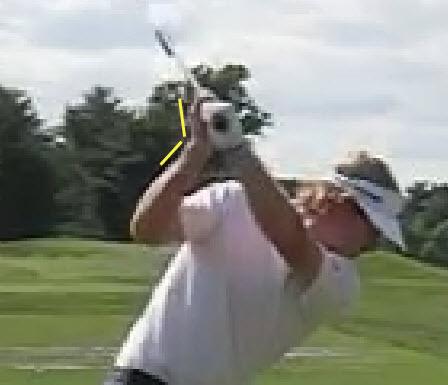
2011 Sneds has his clubface more open at the top of the backswing in order to enable an underflip release without disastrous hooks. But this underflip comes at a cost. Loss of distance and added spin. This is degradation due to an ASSUMPTION that’s made by classic instruction that believes that a closed clubface at the top will automatically cause a hook.
On another note, some experts even believe that a closed clubface at the top will cause back problems. Absurd. But imagine what these teachers think? If you flip it, you save your back. Well that could be true but how about if it ruins your career?
From 2012 Bridgestone golf ball commercial. Though he’s probably posing for the video, he’s got more of a flip/roll element to his release. See right forearm pronation through impact? More left wrist extension/left forearm supination too? This isn’t what made him Rookie of the Year.
From 2008, he had more of a drive/hold release. No doubt that he’s a thoroughbred but even they are not immune from disease. Hmmmmmm. Another one bites the dust.
Charles Howell III
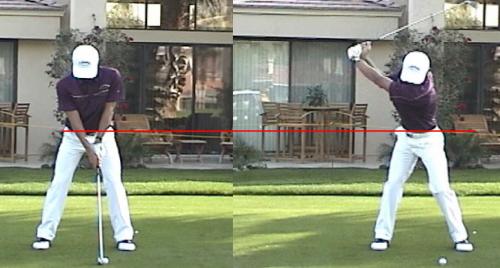
Here’s an older video of Charles Howell III. Looks so good. Not a lot of LPT on the backswing but when you start to dissect the movement... So he’s got a bit of right knee flexion, lowering of the pelvis and APT on the backswing.
Does is make sense why he would be rising up on the downswing? As he extends the right knee and has early PPT, it would have to make you go up.
Here’s Charles from earlier this year showing that you can change the paint job but the motor still has a little sputter in it. Still rising up in transition.
Pelvis moving toward the ball and sliding forward in right pelvic tilt, early right hip IR and abduction. Looks pretty but not legendary.
Lexi Thompson
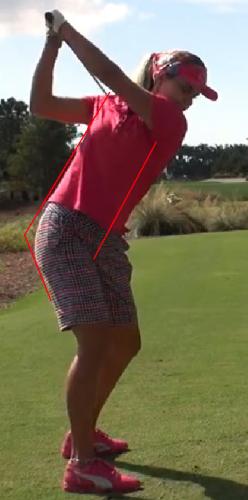
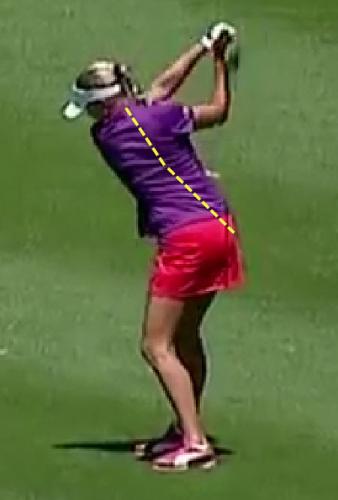
Weight forward toward the ball and on left foot presents a huge challenge to be dealt with. See how her spine is laterally bent to the right (or away from the ball)?

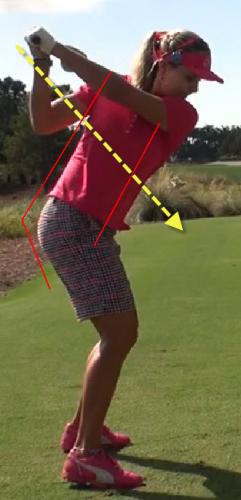
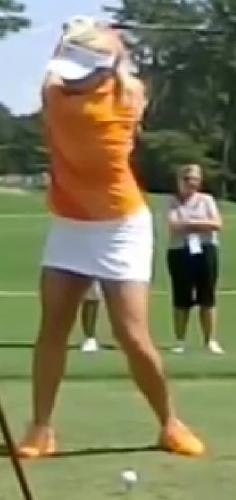

Since the natural movement to swing the club shifts one’s trunk weight down, toward the ball and toward the target, you can see that now, due to her top of the backswing being already off, she has no space to swing her arms to the ball.
I might add that doing a right lateral bend on the backswing will definitely increase right shoulder retraction/abduction therefore it increases the amount your arm/elbow gets behind your right shoulder.

Thus, the right arm/elbow that was already way too far behind her body, stays behind the right hip and she’s stuck.
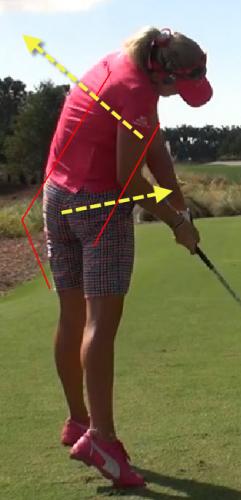
To create the necessary space to swing Lexi must jump to pull her upper torso back and away from the ball. Her lower body must counter that movement by going up and toward the ball. Not quite the way the legends of the game have swung but it’s certainly enough along with her size and talent to win a major on the LPGA tour.
Johnson Wagner
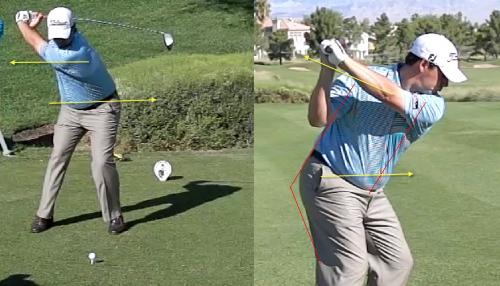
Here’s Johnson Wagner with his unusual swing for a tour player but very common amongst older amateurs. To get to his backswing he does not perform right hip adduction/left hip abduction to shift his pelvis to the right side. Then his spine is in flexion without any thoracic spine extension therefore his upper body sways more away from the target than what we’re used to seeing.
The combination of moves sways his pelvis toward the ball excessively and you can see the result at the top of the backswing.
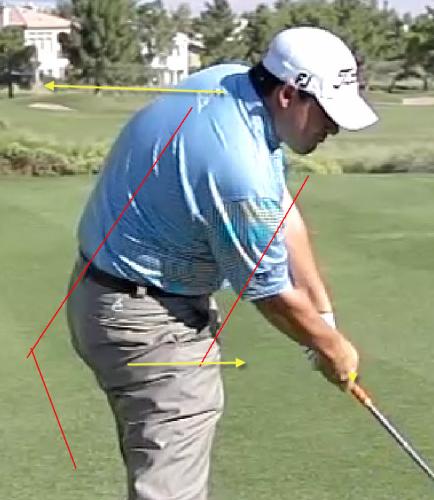
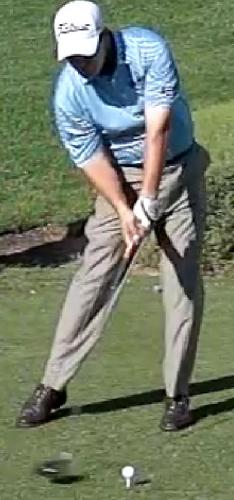
At impact you can see the “loss of spine angle” as his pelvis is thrusted toward the ball while his upper body pulls up and away from the ball a bit. He does have a bit of right lateral bend in his spine but no lordosis. Thus the upper body is moving on its own while he posts up on the left foot. Once again, some people think this is correct and optimum.
Zach Johnson
Let me preface this with the fact that I love Zach’s move through the ball. He’s a very accurate player with a strong grip, closed clubface at the top while drive/holding and has very stable clubface through impact. But he’s not the longest hitter on the tour due to maybe some questionable instruction?
Here’s top 10 instructor Mike Bender’s article on how to get more power at impact from his Golf Digest article. No doubt he’s been influenced by the science!
http://www.golfdigest.com/golf-instruction/2014-08/mike-bender-power-at-impact-with-zach-johnson
What’s Going on?
Don’t punish me with brutality. Talk to me. So you can see. Oh, what’s going on...
“Most golfers think power comes from turning the body hard on the downswing so it drags the arms and club through impact. Truth is, that's the weakest way to hit the ball. The most powerful way is to start your arms down and let your body actually stop to create a slinging action at impact. I call it snap speed.” - Bender
I don’t see no body stopping snap speed there! Do you?
PUSH INTO THE GROUND AND SWING DOWN FAST- Bender
“From the top, your focus should be swinging your arms down as fast as you can. Your hips will move forward a little, but only a twitch so they can support the arm swing. It's like the sprinter putting his foot in a block: The hips get in position so the legs can push against the ground. Without that resistance, the arms can't start down very fast.” - Bender
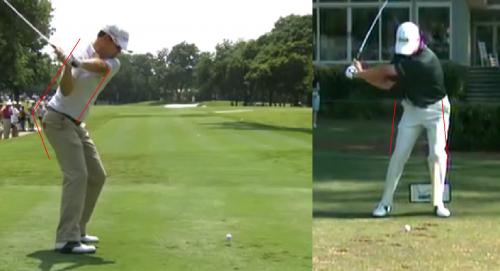
Now this I can see. Student listened to the advice. Pushing into the ground keeps his left hip in IR and hinders rotation.
FACE THE BALL AND POUND THE GROUND - Bender
“Now it's time for your shoulders to brake, which multiplies the speed of your arms. The feeling here is a firming up of the left side, from hip to shoulder. Imagine someone holding your left shoulder in place as you swing down. The goal is to get your chest facing the ball at impact, not turned open.” - Bender
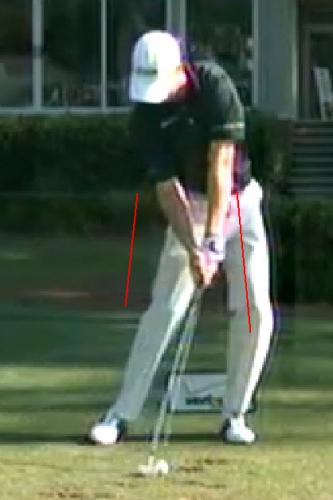
Why are his hips so open??? I thought he was supposed to brake. Bad student!
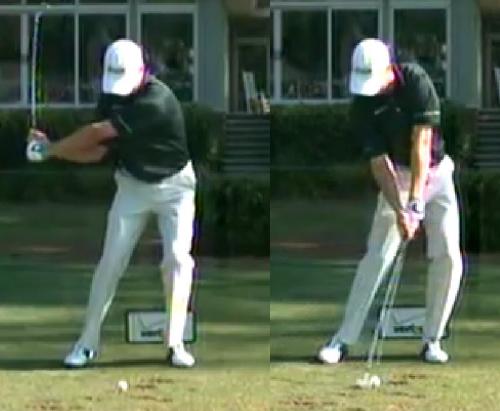
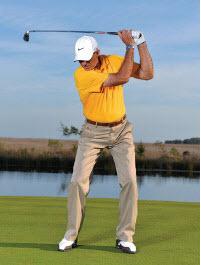
If he listened to the instruction instead of using his athletic intelligence he’d look like Bender with this follow through.
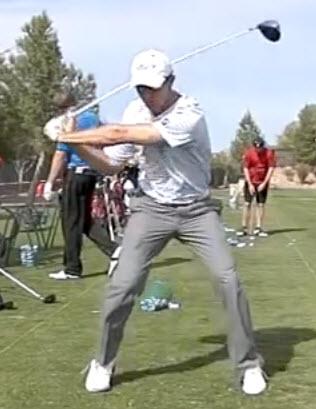
Seriously, if you want to know how to hit it longer wouldn’t you want to copy this guy instead of one of the shorter hitters on tour? If you want to talk physics, shouldn’t you keep your arms and club closer to your body (and not firing arms too early to keep MOI lower) in order to create higher rotational speed of the body which will in turn create more clubhead speed at impact? Why fire arms so early?? The Bender advice would be like a skater lengthening his arms WHILE trying to rotate his/her body rapidly. Illogical.
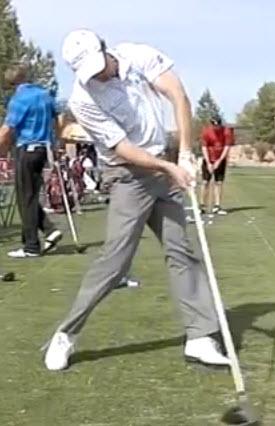
Then rotate as hard as you can through impact. Ain’t nobody trying to stop the body rotation here.
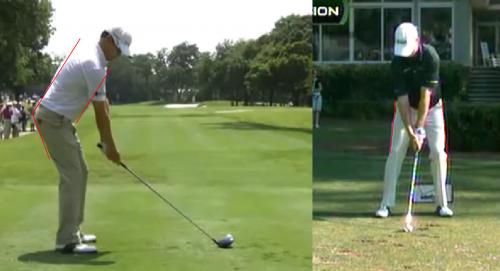
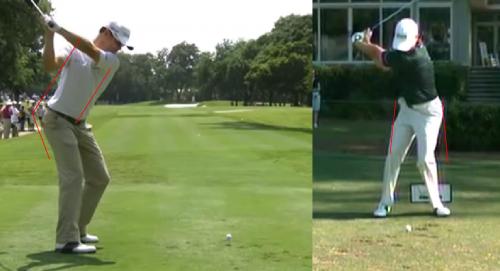
But really, Zach’s problems start on the backswing. By staying on the left, he’s got his weight of his trunk forward toward the ball and on the left foot already. If he were to rotate like Sadlowski from that position, it would create a spin out. His left hip would pull back and away from the ball immediately at the start of the downswing possibly triggering an over the top move. So he’s athletic enough to avoid doing that.

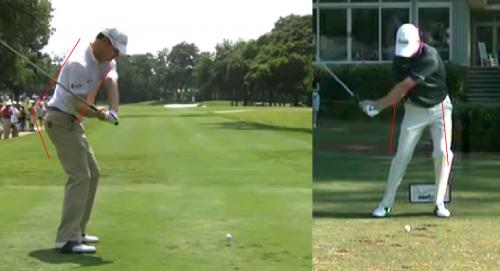
If you don’t turn at the start of the downswing because you’re only supposed to do a small bump of hip while firing the arms, then brace even more at impact to create whopping snap speed, then you wouldn’t hit it out of your shadow. Clearly Zach has enough athletic intuitiveness to rotate his body through impact or there would be no power. But what if he was a good student like most amateurs that buy golf magazines???
Weight Shift is more than a lateral move
Perhaps this is not obvious to everyone but the weight shift in the golf swing or movement of spine has a vertical as well as horizontal component.

So let’s take a look Bubba’s backswing flipped to a right hander. We see shift up and away from the ball as well as away from the target. Again, this is caused by a lateral bending of the spine to the left while extending the lower spine (sagittal or target line view) and extending at the hip joint.

Tiger 2000 showed great athletic movements in his spine too.
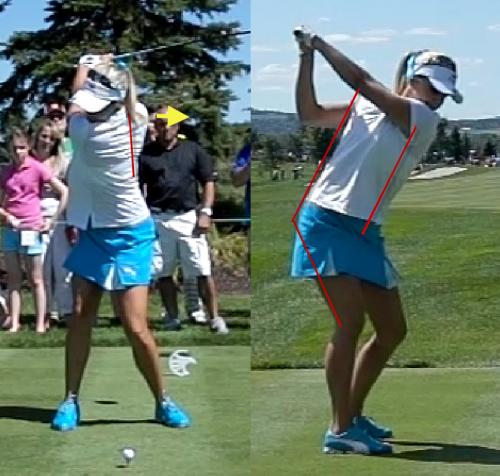
Lexi has a bit of excessive spine extension (frontal plane) plus right lateral bend on the backswing while the lower spine is flexing and flexing at the hip joint. Thus her weight is shifted down, closer to the ball and more toward the target.

Johnson Wagner has his weight more toward the ball, away from the target (spine flexion only) and down.
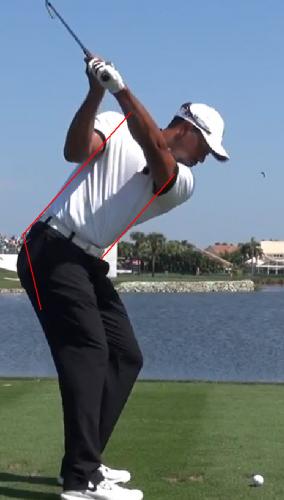
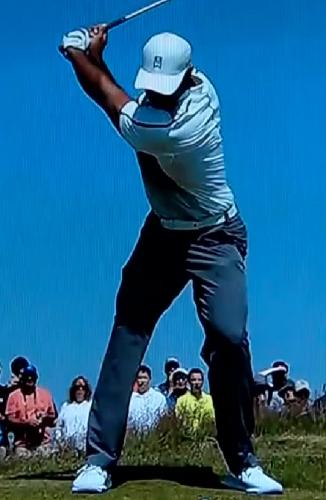
Tiger has his weight more on the left, down toward his toes and more toward the target. This would put him in the same boat as Lexi is. Does this explain why Tiger has to jump up and away from the ball at impact???
So there must be some vertical element which “uploads” the trunk away from the ball on the backswing.
But that shift occurs not in the head or shoulders, it is occurring in the right side of your rib cage lifting up and away from the ball while the “shoulder turn” is occurring. As we will see in a beginner junior golfer shortly, lifting the head to stand up at the top of the backswing will result in a pelvic shift toward the ball thus making the spine too vertical when seen from target line view.
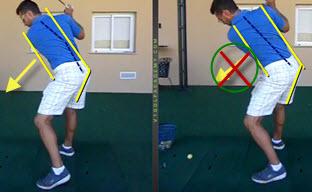
On the downswing, the weight needs to move from up to down. If uploaded, there’s room to go down and use gravity to add power as part of the fluid motion.
But if already downloaded on the backswing, you have two choices; athletically move down even more to the left and toward the ball but have no room to swing plus too much weight on the front foot which then necessitates a huge jump to pull back up. Or you could unathletically pull up from start which would mean coming over the top, no right lateral bend in spine and hit weak fades all day.
Beginner Error
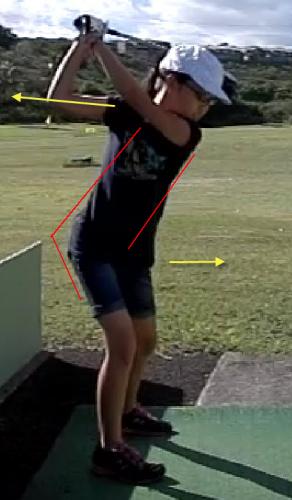
One of my beginning students lacks the body control to do this right. Thus, along with a movement to upload, there is a pelvic movement toward the ball. This changes her posture to be more vertical than she started and is an easy flaw to spot.
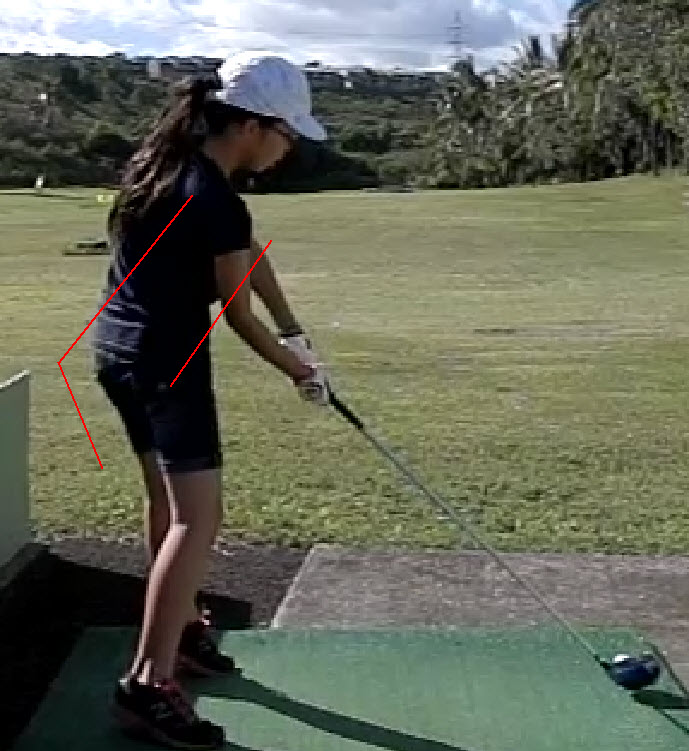
At impact it is inevitable that she’ll be losing her “spine angle” and lateral bend. It is virtually impossible to move the pelvis away from the ball on the downswing and make an athletic move. From her top of the backswing position this IS an athletic move to make lemonade out of lemons.
Back to Chuck Cook
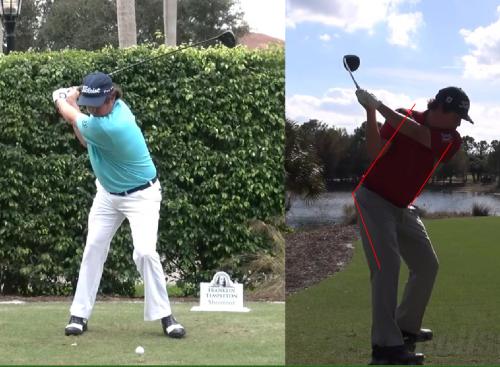 |
 |
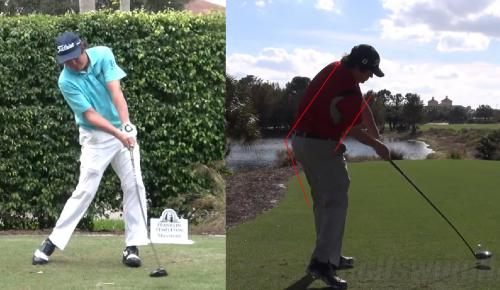
Luke Donald
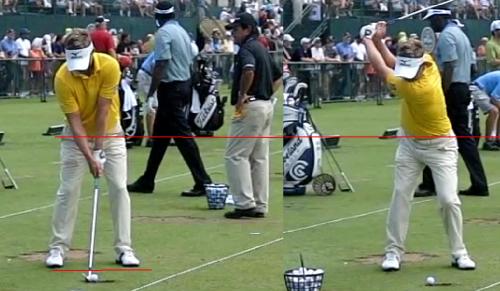
So here we have Luke Donald from a few years ago with a little drop of his pelvis on the backswing. What else is going on?
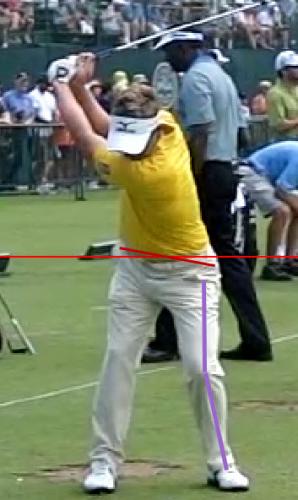
Well there’s a bit more left pelvic tilt (LPT) on the backswing. Left hip is in ER and more than desired flexion of his left knee.
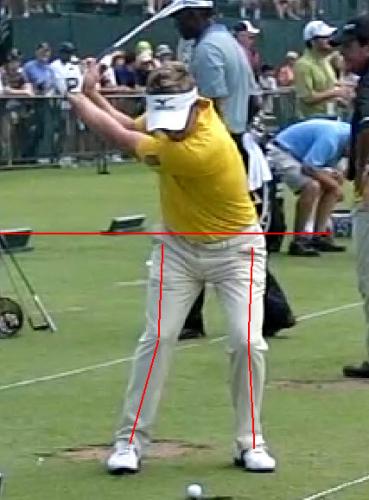
This causes right pelvic tilt (RPT) to start the downswing... maybe some people want that. But then dual IR (internal rotation) occurs to stymie rotation.
So what do you do? You have to either slide more or jump up to escape the bounds of dual IR. As Luke shows, he does a bit of both to get more freedom of movement.
But aside from his little drop in pelvis, LPT and too much flexion to his left knee, he was in pretty good shape. Could be fixed relatively easily...

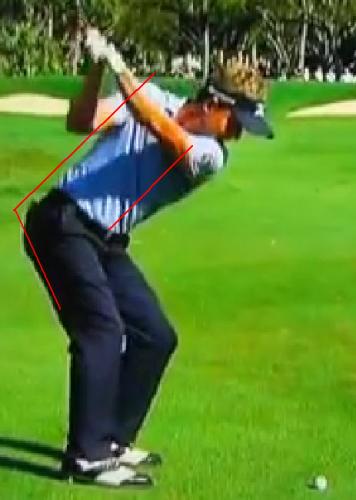
So how he’s doing since switching over to Chuck Cook? The picture on the right is from earlier this year. This shows a bit of the relationship between the trunk balance movements and right shoulder abduction. The more your body moves down toward the ball, the farther back your hands will typically get (right shoulder abduction) and flatten your backswing.


I understand that Cook is trying to get Luke to “swing more left” and “get more rotational” but this is where it gets more difficult. Can you see where Dufner has ZERO right shoulder abduction (means his right humerus/arm stays adducted and does not move behind his body)? Luke has added some from his earlier years therefore you see more of his right humerus. How do you swing more left from here?
Let me just guess at the problems that will be created.
Doing more right shoulder abduction on the backswing means more right shoulder adduction needed on the downswing. Sounds simple but then his trunk balance is so far down and toward the ball. After transition, it’ll be even closer to the ball thus IF keeping right lateral bend, right shoulder ER and ADD wouldn’t this flatten his downswing even more. In addition there will be less space to swing the club. So what’s the answer?
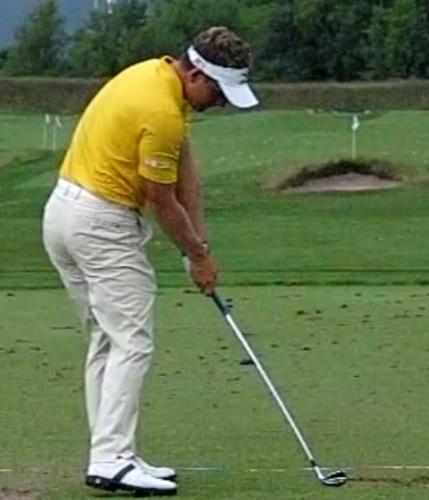
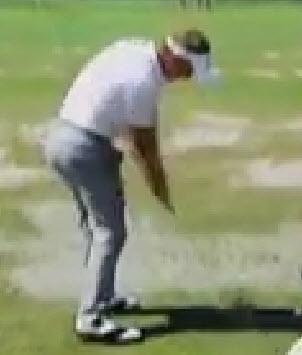
Piece of cake! Yellow shirt Luke is his old swing. When you’re stuck and too flat, classic instruction has an easy fix... ”throw the club down and at the ball.” In our language that means reduce lateral bend, fire earlier right shoulder IR, extend the right arm (which may also cause more right forearm pronation and right wrist flexion thus more flip/roll potential) and this even triggers the abs to contract earlier thereby reducing lordosis (that’s why we see the spine move to flexion well before impact).
This also explains the loss of rotation at impact. So again we’re in a quandary. How do you swing more left when you’ve lost rotation at impact? Ultimately all of this affects his release style. We don’t have good front view video of him from this year but I can guess given the anatomical movements from his right side in addition to his historically fast rolling release. Let me give this a try.
If Luke swung left while doing all the new movements + his old rolling release = the ball will pull hook. So Trackman says your clubface is too closed causing the pull hook. Classic instruction simple fix is to hold off the “release” and stop rolling the hands. Got it Luke? So just keep your left forearm from supinating and you’re gold (try to copy Duf’s left hand at impact albeit without his great rotation and trunk balance at the top of backswing)!
But there’s an unintended consequence of this. If you take away left forearm supination, you’re naturally moving more toward keeping left forearm pronation while also taking away left wrist flexion (which means more left wrist extension) thus moving the release pattern to more of a flip to hit it straight (remember left wrist flexion and supination at impact can no longer work with this swing because it causes pull hooks). But the flip creates the powder puff straight fade and the push fade. So how do you fix that? Roll it more but not too much!!!
Do you see how this can create two different sets of release patterns (Jekyll and Hyde) and a massive need for precision timing? Roll too little and you get a push fade, roll too much or too fast and you get a pull hook.
Sound like Tiger’s problems??? Gotta get worse before you get better or just getting worse??? 10,000 more repetitions. Get stronger. Get healthier. Get a sports psychologist. Get a new supermodel girlfriend?
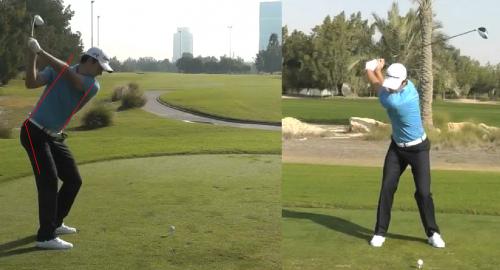
In case you’re wondering, this is Justin Rose. Capeesh?
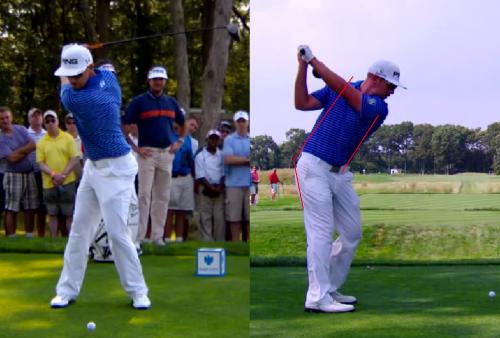
Hunter Mahan doesn’t look like Tiger either. So what is Foley teaching Tiger?
Develop Great Moves or become a Method Man?
A lot of these problems need to be fixed at the root. But many golfers and even tour pros fall into the trap of trying to learn a method instead of fixing a flaw. In doing so, they buy into the new paint job before they fix the engine. Or they’re exchanging the engine of the Formula 1 car for a Volkswagen Bug engine because the method said so. Insanity?
Perhaps, yet it happens all the time and the only guy we know it isn’t going to happen to is Bubba.
Each of these popular methods has a bit of truth to them. But the reality is that it will only work for the few people where the method excels by actually fixing a flaw. Take for example Johnson Wagner with his spine flexion only backswing. If he were to do a bit (not the whole enchilada) of stacking and tilting it might help him find the Goldilocks zone of correctness for creating some thoracic spine extension. But if devoted to it for years, soon we’d see him go overboard with the “accuracy” swing that would make him a great short iron player but can’t hit the driver. Ultimately the dogma of the method takes precedence over the pragmatism of hitting it better with just a little bit of the fix that improves you.
Yet that is the trap. If some improvement due to the dogma is good. More is better. So you swallow the entire program.
Contrast that to developing better moves, fixing flaws of your swing and ultimately taking small steps toward a great golf swing each day. There’s no reason to buy into any dogma. There is no one way! Or two or three even. There are millions of combinations of moves to swing the club effectively.
Each individual has their own uniquely human body that can only express their own movement patterns with different speeds/intensities based on their strengths, weaknesses, prior sports experience, myelinated pathways, fitness level, genetics, etc. Just as no two fingerprints are alike, no two golf swings are alike and regardless of how much you try, you will never have the same swing as Ben Hogan, Rory McIlroy, Tiger Woods, Jamie Sadlowski or whoever your idol is. But you can add a few of their moves and improve a little at a time.
Addendum: The Sean Foley era has ended for Tiger. Since he’s finally come to his senses, let’s hope this is a lesson to all. If perhaps the greatest golfer of all time can’t learn a method, how will you? And for all the talk about how great the Trackman is, how did it fail Tiger? And why was Tiger talking about how fast the clubface was closing after missing the cut at the PGA Championships?

